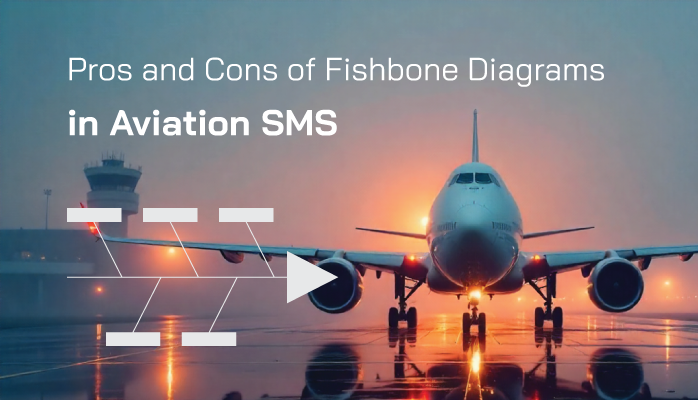What Is a Fishbone Diagram for Aviation Safety Programs

Fishbone diagrams are a lesser known but very effective risk management tool in aviation safety management systems (SMS).
Fishbone diagrams get their name because of their fish-like appearance, with several fins and a head. Each “fin” or “branch” of a fishbone diagram describes a different element of the safety issue, such as “Man” and “Machine.” The head describes the Top Event (also known as Risk Event, the point at which safety control is lost).
Related Aviation Safety Risk Management Articles
- 20 Questions for Your Safety Risk Management Process in Aviation SMS [With Free Checklists]
- 4 Elements of Safety Risk Management (SRM)
- Best Safety Risk Management Practices for Aviation Maintenance
Fishbone Diagrams Illustrate Cause and Effect
Fishbone diagrams are also known as Cause and Effect diagrams, or Ishikawa diagrams. In operational environments, they are usually used to:
- Establish causes and effects that lead to safety issues;
- Understand the relationship between causes and effects; and
- Explore root causes of a safety issue.
Unlike other risk management tools, such as a Risk Matrix, the fishbone diagram does not include any subjective elements like likelihood or severity. It simply looks at the facts.
Also, fishbone diagrams are only concerned with the events that precede the Top Event, and not with events that come after.
How to Create Fishbone Diagrams
We discuss how to create fishbone diagrams in greater detail in another article that we link to above. However, the basic steps work like this:
- Choose a model framework to create the “fins”, such as the SHELL model or 5-M model (or create your own);
- Establish the Top Event – the point at which safety control is lost – and add it to the “head” portion of the diagram;
- Establish primary causes in each fin and create smaller branches for each of those causes; and
- For each primary cause, establish the root cause by asking “Why did this happen.”
Once finished, there are a couple of things to note:
- Root causes may appear in more than one fin because of overlap;
- Some fins may have very few items; and
- Bolding the most important root causes will be helpful for future reference.
Creating fishbone diagrams is actually surprisingly easy with a bit of practice. Not every reported safety issue will warrant a fishbone analysis in your SMS' documented risk management processes.
Related Aviation SMS Risk Management Articles
- Difference Between Reactive, Predictive and Proactive Risk Management in Aviation SMS
- What Is the Process of Risk Management in Aviation SMS
- 3 Main Components of Aviation Risk Management
Benefits of Fishbone Diagrams in Aviation SMS

There are some strong benefits of fishbone diagrams in aviation risk management.
- Comprehensive root cause analysis;
- See how causes work together to produce safety issues;
- Understand how effects of causes materialize in an operational environment;
- Objective look at how safety issues originate and develop;
- Over time, will develop a state-of-the-art hazard register;
- Fishbone diagrams are a part of proactive risk management because you are identifying underlying causes and events before safety control is lost;
- Understand contributing factors;
- Can easily develop aviation leading indicators based on findings; and
- Develop superior, comprehensive risk controls.
Moreover, unlike other risk management tools that provide many “comprehensive” benefits, fishbone diagrams can be completed in a relatively short amount of time. This makes fishbone diagrams accessible and useful for nearly all reported safety issues.
We might contrast this to the Bowtie, which also provides “comprehensive” benefits, but takes much more time to complete; thus, it is usually only used on medium/high-risk safety issues.
Cons of Fishbone Diagrams
Despite the numerous “comprehensive” benefits of fishbone diagrams, there are some rather big drawbacks as well. These drawbacks mainly center on the fact that fishbone diagrams only look at the first half of a safety issue.
Remember, anything that happens after the Top Event is not analyzed in fishbone diagrams. The consequences of this are that:
- Fishbone diagrams should be coupled with a second risk management tool that captures events that happen after safety control is lost;
- They are not used for reactive risk management activities (an important part of any SMS program);
- They are (generally) not used for predictive risk management activities;
- They do not capture failures in human behavior or risk controls in reaction to negative events.
We might contrast this with Bowtie analysis again, where Bowtie analysis is comprehensive of events before and after safety control is lost – it covers everything from root causes to final impacts.
Related Aviation Risk Management Articles
- Difference Between Hazards, Risks & Control Measures in Aviation SMS
- How to Conduct Root Cause Analysis in Aviation SMS
- 3 Methods for Root Cause Analysis in Aviation SMS
Scenarios When to Use Fishbone Diagrams
As said, fishbone diagrams can be done quickly enough that they are useful in any situation. In general, however, fishbone diagrams are used when:
- Performing root cause analysis;
- Reviewing breakdowns in risk controls;
- Analyzing contributing factors; and
- Understanding the Role of Human Factors in safety issues.
All of the above scenarios are perfect candidates for situations in which to use fishbone diagrams.
A very useful, user-friendly approach to managing fishbone diagrams is by using aviation SMS database software that includes fishbone diagrams in their risk management processes. SMS Pro has such a tool in the risk management system.
To learn how you can use fishbone diagrams in your risk management processes, check out these short demo videos. SMS Pro has been offering SMS databases to operators since 2007.
For more information about improving other risk management operations, see these workflows:
Last updated August 2025.







